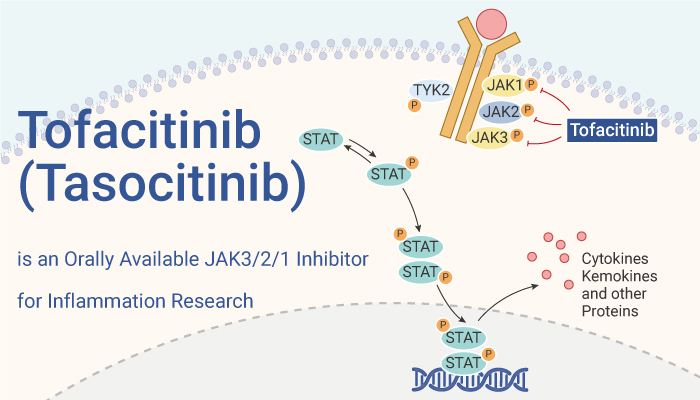JAK is a family of cytoplasmic tyrosine kinases consisting of four isoforms, JAK1, JAK2, JAK3 and TYK2. According to studies, JAKs transduce cytokine-mediated signals through the family of signal transducers and activators of transcription factors (STAT). Moreover, JAK3 always pairs with JAK1 in the common gamma chain of several cytokine receptors (e.g. IL-2, IL-4, IL-7, IL-9, IL-15, IL-21) and is primarily associated with adaptive immunity. In addition, JAK1 also pairs with JAK2 in type II INFg receptor as well as with JAK2 and Tyk2 in gp130 subunit sharing receptors for IL-6, important pro-inflammatory cytokines primarily associated with the innate immune response. Besides, JAK2 is the only JAK that pairs with itself in the IL-3 and IL-5 cytokine receptors, but also in the receptors of GM-CSF, erythropoietin (EPO) and thrombopoietin (TPO), indicating that JAK2 plays a role not only in the signalling of proinflammatory cytokines, but also in processes of haematopoiesis. Moreover, JAK2 also pairs with Tyk2 in the IL-12 and IL-23 cytokine receptors that are associated with Th1 and Th17 differentiation, respectively. Hence, we will introduce a JAK3/2/1 inhibitor-Tofacitinib (Tasocitinib; CP-690550). Hence, we will introduce a JAK3/2/1 inhibitor-Tofacitinib(Tasocitinib; CP-690550).

Tofacitinib is an JAK3/2/1 Inhibitor, with IC50s of 1, 20, and 112 nM, respectively.
In vitro, Tofacitinib (300 nM; 48 h) inhibits expression of CD80 and CD86 through reduction of IRF7 signalling in MoDCs. In addition, Tofacitinib (10, 100, 300, 1000; 48 h) reduces T cell stimulatory ability and induced expression of IDO in MoDCs.
Tofacitinib (30 mg/kg; i.p.; 30 min after LPS) completely inhibits LPS-induced pSTAT3 expression both in the airways and in parenchyma. In addition, Tofacitinib (30 mg/kg; i.p.; 1 h before LPS challenge) also inhibits dose-dependently LPS-induced IL-6 and MIP-1a with complete inhibition of IL-6 and 89% inhibition of MIP1a.
All in all, Tofacitinib is a promising JAK3/2/1 inhibitor for chronic inflammatory disorders research.
Reference:
[1] Jiang JK, et al. J Med Chem. 2008 Dec 25;51(24):8012-8.
[2] Kubo S, et al. Ann Rheum Dis. 2014 Dec;73(12):2192-8.
[3] Calama E, et al. Pulm Pharmacol Ther. 2017 Apr;43:60-67.